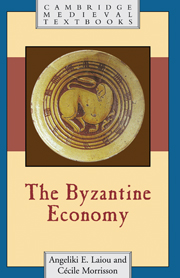Book contents
- Frontmatter
- Contents
- List of maps
- List of figures
- List of tables
- Acknowledgements
- List of abbreviations
- Introduction
- I Natural and human resources
- II The Late Antique economy and the shift to medieval structures (sixth–early eighth centuries)
- III Restructuring, recovery and controlled expansion (early eighth to tenth centuries)
- IV The age of accelerated growth (eleventh and twelfth centuries)
- V Small-state economics (from sometime in the thirteenth century to the fifteenth century)
- VI The Byzantine economy as exemplar; the Byzantine and the Western medieval economies
- Select bibliography
- Index
- Cambridge Medieval Textbooks
IV - The age of accelerated growth (eleventh and twelfth centuries)
Published online by Cambridge University Press: 05 June 2012
- Frontmatter
- Contents
- List of maps
- List of figures
- List of tables
- Acknowledgements
- List of abbreviations
- Introduction
- I Natural and human resources
- II The Late Antique economy and the shift to medieval structures (sixth–early eighth centuries)
- III Restructuring, recovery and controlled expansion (early eighth to tenth centuries)
- IV The age of accelerated growth (eleventh and twelfth centuries)
- V Small-state economics (from sometime in the thirteenth century to the fifteenth century)
- VI The Byzantine economy as exemplar; the Byzantine and the Western medieval economies
- Select bibliography
- Index
- Cambridge Medieval Textbooks
Summary
There is no question that the Byzantine economy experienced secular growth in the period after the late eighth century. What is argued in this chapter is that growth accelerated over a period which extended from sometime in the tenth century until a point that varies considerably for the various sectors of the economy as well as in terms of the factors that influence growth. The demographic upward swing continued until some time in the early or mid-fourteenth century. The rural population was in a Malthusian bind by the late thirteenth–early fourteenth century, as the land constraint appears to have been reached, diminishing returns set in and, as a result, the economic condition of the population worsened. The urban economy reached its heights in the twelfth century; and the economy of exchange, which certainly attained high levels in the twelfth century, functioned under significantly different terms in the period after the fall of Constantinople to the crusaders in 1204. That there was extensive growth in this period is quite clear. The question will also be raised whether one may also speak of what D. Lal has called a “Smithian intensive growth,” with a secular increase in the per capita income that, however, in the long run comes up against the land constraint and diminishing returns set in.
DEMOGRAPHY
In examining the growth patterns of the age of accelerated growth one must, once again, begin with demography and population movements, for a number of reasons.
- Type
- Chapter
- Information
- The Byzantine Economy , pp. 90 - 165Publisher: Cambridge University PressPrint publication year: 2007

